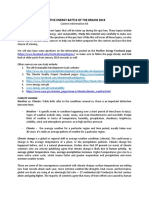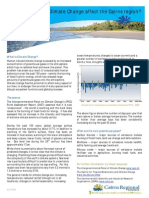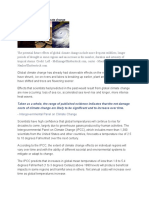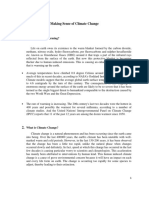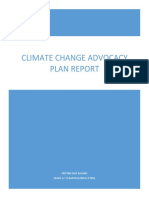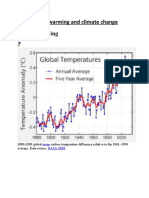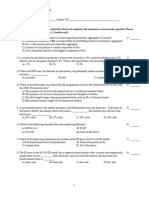04_Handout_1(24)
04_Handout_1(24)
Uploaded by
merrantoinetteCopyright:
Available Formats
04_Handout_1(24)
04_Handout_1(24)
Uploaded by
merrantoinetteCopyright
Available Formats
Share this document
Did you find this document useful?
Is this content inappropriate?
Copyright:
Available Formats
04_Handout_1(24)
04_Handout_1(24)
Uploaded by
merrantoinetteCopyright:
Available Formats
SH1736
Climate Change
I. Climate Change
It is a change in the usual weather found in a place. This could be a change in how much
rain a place usually gets in a year. Or it could be a change in a place's usual temperature for a
month or season. It can be also defined as a change in Earth’s climate (www.nasa.gov, 2014).
A. Causes of Climate Change
1. Greenhouse gases
Certain gases in the atmosphere block the heat from escaping. Thus, producing
a phenomenon called greenhouse effect (climate.nasa.gov). Many of these gases
occur naturally, but human activity is increasing the concentrations of some of them
in the atmosphere. The main greenhouse gases are carbon dioxide, methane, nitrous
oxide, and fluorinated gases (ec.europa.eu).
2. Human activities
According to the Intergovernmental Panel on Climate Change (2014), there’s
more than 95% probability that the industrial activities of humans over the past 50
years have warmed our planet.
Since the Industrial Revolution began in 1750, human activities have
contributed tremendously to climate by adding carbon dioxide and other heat-
trapping gases to the atmosphere. These greenhouse gas emissions increased the
greenhouse effect and resulted in an increase in the temperature of the Earth’s
surface (Dela Cruz, A., Fadrigon, C., Mabaquiao Jr., N., 2017)
3. Solar irradiance
Changes in the sun's energy output would cause the climate to change since the
sun is the fundamental source of energy that drives our climate system.
B. Effects of Consumption Patterns to Climate Change
Household consumption forms an important part of the production-consumption
chain as it is consumers who make the final choice as to which goods and services to
buy. Even though the environmental pressures caused by each household are relatively
small compared to those caused by production activities, billions of households around
the world combined are a major contributor to environmental problems such as climate
change, air and water pollution, land use, and waste segregation.
In the last ten years, we have seen major developments that have changed how and
what we consume. One is economic growth, globalization and the opening of markets.
As we become wealthier, we consume more. Another development is that households
are getting smaller on average, and partly because of that we use more energy and water
and generate more waste per person.
The energy, materials, and resources we use have direct and indirect impacts on the
environment. Generally speaking, the indirect environmental effects of consumption
are higher than the direct ones. For example, when we prepare and eat food, the direct
environmental effects of the cooking process are considerably less than the combined
indirect effects of pollution and waste from the agricultural production, the industrial
processing of the food and its transportation (econation.co.nz).
04 Handout 1 *Property of STI
Page 1 of 4
SH1736
C. Effects of Climate Change
1. Temperatures will continue to rise
Because human-induced warming is superimposed on a naturally varying
climate, the temperature rise has not been, and will not be, uniform or smooth across
the country or over time. (climate.nasa.gov)
According to study on the Climate Change by DOST-PAGASA (2011), the
mean temperatures in all areas in the Philippines are expected to rise by 0.9 °C to
1.1 °C in 2020 and by 1.8 °C to 2.2 °C in 2050.
2. Changes in precipitation patterns
Through DOST-PAGASA’s study on 2011, they have projected that heavy
rainfall will continue to become more frequent in Luzon and Visayas only, but the
number of dry days is expected to increase in all parts of the country in 2020 and
2050.
3. More droughts and heat waves
As wet seasons become wetter in the country, dry seasons are also expected to
become drier leading to more occurrences of dry spells or droughts. There will be
more days which have a maximum temperature exceeding 35 °C in 2020 and 2050
(DOST-PAGASA, 2011).
4. Strength and intensity of typhoons and hurricanes will increase
The destructive power of the typhoons that wreak havoc across China, Japan,
Korea and the Philippines has intensified by 50% in the past 40 years due to
warming seas (theguardian.com).
On the other side of the globe, the intensity, frequency, and duration of North
Atlantic hurricanes, as well as the frequency of the strongest (Category 4 and 5)
hurricanes, have all increased since the early 1980s. The relative contributions of
human and natural causes to these increases are still uncertain. Hurricane-
associated storm intensity and rainfall rates are projected to increase as the climate
continues to warm (climate.nasa.gov).
5. Rise of sea level by one (1) to four (4) feet by 2100
Global sea level has risen by about 8 inches since reliable record keeping began
in 1880. It is projected to rise another 1 to 4 feet by 2100. This is the result of added
water from melting land ice and the expansion of seawater as it warms.
In the next several decades, storm surges and high tides could combine with sea
level rise and land subsidence to further increase flooding in many regions. Sea
level rise will continue past 2100 because the oceans take a very long time to
respond to warmer conditions at the Earth’s surface. Ocean waters will, therefore,
continue to warm and sea level will continue to rise for many centuries at rates
equal to or higher than those of the current century (climate.nasa.gov).
6. Ocean acidification
According to Pacific Marine Environmental Laboratory of National Oceanic
and Atmospheric Administration of United States, the acidity of ocean waters has
risen by 30 percent since the beginning of the Industrial Revolution. Future
predictions indicate that the oceans will continue to absorb carbon dioxide and
become even more acidic.
Estimates of future carbon dioxide levels, based on business as usual emission
scenarios, indicate that by the end of this century the surface waters of the ocean
04 Handout 1 *Property of STI
Page 2 of 4
SH1736
could be nearly 150 percent more acidic, resulting in a pH that the oceans haven’t
experienced for more than 20 million years (pmel.noaa.gov).
D. Steps to Address the Problems of Climate Change
1. Mitigation and Adaptation Approaches
Mitigating climate change means reducing the impacts of climate change. To
do this, the United Nations Intergovernmental Panel on Climate Change (2014)
requires the following: (1) prevention of hazardous human intervention with the
climate system; and (2) the stabilization of greenhouse gas levels based on a time
frame that would allow ecosystems to adapt to climate change. The stabilization of
the ecosystem will eventually lead to a sufficient food supply and sustainable
economic development
Adaptation – adapting to life in a changing climate – involves adjusting to actual
or expected future climate. While climate change is a global issue, it is felt on a
local scale. Cities and municipalities are therefore at the frontline of adaptation. In
the absence of national or international climate policy direction, cities and local
communities around the world have been focusing on solving their own climate
problems. They are working to build flood defenses, plan for heat waves and higher
temperatures, install water-permeable pavements to better deal with floods and
stormwater and improve water storage and use (climate.nasa.gov).
2. What can we do to help address climate change? (Dela Cruz, Fadrigon, &
Mabaquiao Jr., 2017)
a. At home
Here are some simple steps that you can do to help reduce greenhouse gas
emissions:
Change light bulbs – Choose light emitting diode (LED) bulbs and
compact fluorescent lamps (CFL) over incandescent bulbs because it is
more energy efficient and it lasts longer.
Reduce, reuse, and recycle – We can’t stop ourselves from producing
waste as long as we live but an efficient waste management will make a
huge difference.
Use water efficiently – Heating, pumping and treating water use a lot of
energy and because of this, saving water consumption can help reduce
greenhouse gas emissions. Saving water is a very simple way to help
the environment.
Practice composting – Composting helps to reduce the amount of
garbage sent to landfills by converting food and yard waste into natural
fertilizers.
b. At the office
Office consumes a large amount of electricity for cooling, lighting, and
operating different equipment. Here are a number of steps that you can do to
help protect the environment and help address climate change.
Manage your office equipment energy wisely – Save energy by turning
off computer monitors and other office equipment when not in use.
Always unplug power cords when they are not used and always turn off
equipment and lights at the end of the day.
04 Handout 1 *Property of STI
Page 3 of 4
SH1736
Learn to commute – Using public transportation, carpooling, or biking
when going to work or school can save energy and reduce greenhouse
gas emissions.
Reduce, reuse, and recycle – Recycle papers and use them as scratch
papers. Instead of throwing used computers or equipment, donate them
to organizations that needed them.
c. On the road
Buy a fuel-efficient and low-greenhouse has vehicle – If you are
planning to buy a new car, choose the cleanest, most fuel-efficient
vehicle that can satisfy your needs.
Drive smart – Go easy on the breaks and gas pedal, avoid hard
accelerations, lessen your time idling, and remove unnecessary items in
your trunk to reduce weight. These are the simple tips that you could
follow to improve your car’s fuel economy.
Ensure proper car maintenance – Always have regular vehicle tune-ups
and follow car’s maintenance schedule. If your car is well-maintained,
you are assured that it is more fuel-efficient and more reliable.
Check tires regularly – Check your tire pressure regularly. Cars with
under-inflated tires increase tire wear and reduce car’s fuel economy.
Use renewable fuels – Use renewable fuels and green fuels for your car
to help reduce greenhouse gas emissions and air pollution.
References:
2011, February. Climate Change in the Philippines. Retrieved on August 31, 2017, from
http://dilg.gov.ph/PDF_File/reports_resources/DILG-Resources-2012130-2ef223f591.pdf
2016, September 05. Asian typhoons becoming more intense, study finds. Retrieved on August 31, 2017, from
https://www.theguardian.com/environment/2016/sep/05/asian-typhoons-becoming-more-intense-study-finds
A blanket around the Earth. (n.d.). Retrieved on August 25, 2017, from https://climate.nasa.gov/causes/.
Causes of Climate Change. (n.d.). Retrieved on August 25, 2017, from https://ec.europa.eu/clima/change/causes_en.
Climate Change 2014 Synthesis Report Summary for Policymakers. (2014). Retrieved on August 25, 2017, from
http://ipcc.ch/pdf/assessment-report/ar5/syr/AR5_SYR_FINAL_SPM.pdf
Dela Cruz, A. D., Fadrigon, C. C., & Mabaquiao, N. M., (2017). Trends, Networks, and Critical Thinking in the 21 st
Century Culture. Quezon City: Phoenix Publishing House, Inc.
May, S. (2014). What Is Climate Change? Retrieved on August 25, 2017, from
https://www.nasa.gov/audience/forstudents/k-4/stories/nasa-knows/what-is-climate-change-k4.html
Population and Consumption. (n.d.). Retrieved on September 4, 2017, from https://econation.co.nz/population-and-
consumption/
What is Ocean Acidification? Retrieved on August 31, 2017, from
https://www.pmel.noaa.gov/co2/story/What+is+Ocean+Acidification%3F
04 Handout 1 *Property of STI
Page 4 of 4
You might also like
- Research PaperDocument30 pagesResearch PaperELAURZA DRYCA G.No ratings yet
- STS MODULE 5 Climate ChangeDocument10 pagesSTS MODULE 5 Climate Changeej cruzNo ratings yet
- MAGeog 112Document7 pagesMAGeog 112Payal SinghNo ratings yet
- 2 ND NumberDocument6 pages2 ND NumberManish JoshiNo ratings yet
- Lesson 3 Climate ChangeDocument8 pagesLesson 3 Climate ChangeGhie MoralesNo ratings yet
- Science Mahara ProjectDocument9 pagesScience Mahara ProjectoreoplushiesNo ratings yet
- Ijsrp p8791Document6 pagesIjsrp p8791madiihahNo ratings yet
- Botb Semis Info Kit 2019 PDFDocument30 pagesBotb Semis Info Kit 2019 PDFJessa Casile VillacampaNo ratings yet
- Climate Change Primer Final PDFDocument21 pagesClimate Change Primer Final PDFDax Kin Dy VintolaNo ratings yet
- Env Law End TermDocument13 pagesEnv Law End TermSadhvi SinghNo ratings yet
- Global warming research paper lawDocument33 pagesGlobal warming research paper lawananya pandeyNo ratings yet
- Cebu Technological University: Name: Keno K. NatadDocument5 pagesCebu Technological University: Name: Keno K. NatadJamesNo ratings yet
- EssayDocument3 pagesEssayVijayant DalalNo ratings yet
- GE (3486) DelenaDocument12 pagesGE (3486) DelenaCHARISSE RAZELLE DELE�ANo ratings yet
- Climate Change Article 2Document21 pagesClimate Change Article 2nmedallaNo ratings yet
- (GED109) CH 11 Climate Change, Energy Crisis and Environmental AwarenessDocument22 pages(GED109) CH 11 Climate Change, Energy Crisis and Environmental Awarenesspreclipse789123No ratings yet
- NSTP Lts Module 5 10Document60 pagesNSTP Lts Module 5 10Black PrankNo ratings yet
- Climate Change: Impacts On Fisheries and AquacultureDocument20 pagesClimate Change: Impacts On Fisheries and AquacultureLakshmana KvNo ratings yet
- Climate Change Refers To The Rise of Global Temperatures Which Has Led To Global WarmingDocument6 pagesClimate Change Refers To The Rise of Global Temperatures Which Has Led To Global WarmingAsiashumaanda MabiluNo ratings yet
- Definition of Climate ChangeDocument14 pagesDefinition of Climate ChangeMari GovinNo ratings yet
- How Will Climate Change Affect The Cairns Region?Document2 pagesHow Will Climate Change Affect The Cairns Region?kurabyqld100% (1)
- A Report On Solving Climate Change Crisis Through Developmentof Renewable EnergyDocument21 pagesA Report On Solving Climate Change Crisis Through Developmentof Renewable EnergyEmmanuel FasuyiNo ratings yet
- Global CLimateDocument2 pagesGlobal CLimateAnonymous yNEhpqwoPNNo ratings yet
- Climate Science - CSS05-19 - 0Document2 pagesClimate Science - CSS05-19 - 0rizzalyn.alinsasaguinNo ratings yet
- DocumentDocument11 pagesDocumentGuille Adriel RegualcionNo ratings yet
- Climate Change: Tanpo. Tare. Tio. Tiu. VelascoDocument27 pagesClimate Change: Tanpo. Tare. Tio. Tiu. VelascoJoan PaulineNo ratings yet
- Module 5 Environmental ProtectionDocument27 pagesModule 5 Environmental ProtectionChen HaoNo ratings yet
- Climate ChangeDocument18 pagesClimate ChangeKhushnuma ParveenNo ratings yet
- 10.ClimatechangeimpactonhorticulturalcropsDocument12 pages10.Climatechangeimpactonhorticulturalcropsbamidelelawrence114No ratings yet
- "That So Many of Us Are Here Today Is A Recognition That The Threat From Climate Change Is SeriousDocument2 pages"That So Many of Us Are Here Today Is A Recognition That The Threat From Climate Change Is SeriousRuela Mae CospadaNo ratings yet
- Mine-Envi Technical-Report FinalDocument28 pagesMine-Envi Technical-Report FinalMcAndrew GaveriaNo ratings yet
- Effects of Climate ChangeDocument10 pagesEffects of Climate ChangeJan100% (1)
- Climate Crisis Unveiled: A Comprehensive Guide to Understanding Climate ChangeFrom EverandClimate Crisis Unveiled: A Comprehensive Guide to Understanding Climate ChangeNo ratings yet
- Making Sense of Climate Change: What Is Global Warming?Document6 pagesMaking Sense of Climate Change: What Is Global Warming?veer barsiwalNo ratings yet
- ArticleDocument11 pagesArticlenawaltNo ratings yet
- Module 5 Climate ChangeDocument10 pagesModule 5 Climate ChangeNizea Camille Navarro JavierNo ratings yet
- Climate Science - css05-19 - E2021Document2 pagesClimate Science - css05-19 - E2021Lê Gia HuyNo ratings yet
- Module: Environmental Protection: Topic: Global WarmingDocument11 pagesModule: Environmental Protection: Topic: Global WarmingJam CamaligNo ratings yet
- GW&CC Unit-3 MaterialDocument16 pagesGW&CC Unit-3 MaterialShaik TajuddinshavaliNo ratings yet
- ENV_107_Lecture_14_Climate ChangeDocument33 pagesENV_107_Lecture_14_Climate ChangeHaniyum MariaNo ratings yet
- Climate ChangeDocument7 pagesClimate ChangepjcolitaNo ratings yet
- Science CCL Project Climate ActionDocument18 pagesScience CCL Project Climate Actionkamya konchadaNo ratings yet
- CHAPTER 11.3 Global Warming and Its ImpactDocument8 pagesCHAPTER 11.3 Global Warming and Its Impacts.bitancor.sarimalrashidNo ratings yet
- Climate Change Advocacy Plan Report: Kristina Mae Bayano Grade 12 ST - Bartholomew (Stem)Document7 pagesClimate Change Advocacy Plan Report: Kristina Mae Bayano Grade 12 ST - Bartholomew (Stem)Hazel BayanoNo ratings yet
- Faisal Clmte CNGDocument30 pagesFaisal Clmte CNGFaisal WarraichNo ratings yet
- A Seminar Paper On Climate Change and Its Effects On Aquatic EnvironmentDocument25 pagesA Seminar Paper On Climate Change and Its Effects On Aquatic EnvironmentIorhee saviourNo ratings yet
- STS C4 Lesson 6 Climate ChangeDocument7 pagesSTS C4 Lesson 6 Climate Changecarlapilapilsurmieda12No ratings yet
- Gecw 8 The Contemporary WorldDocument4 pagesGecw 8 The Contemporary WorldAelaMontenegroNo ratings yet
- Climate Change Adaptation and MitigationDocument39 pagesClimate Change Adaptation and Mitigationldrrm naga100% (2)
- Essay on Enviornment ChallangesDocument23 pagesEssay on Enviornment ChallangesNamal SandunNo ratings yet
- Energy Engineering Chapter 7Document13 pagesEnergy Engineering Chapter 7Ajaya KarkiNo ratings yet
- Climate Change: 6.1 Causes and ImpactsDocument13 pagesClimate Change: 6.1 Causes and ImpactsBipin AdhikariNo ratings yet
- Effect of Global Warming On Livelihood - Case Study - Birnin Kudu September 14 Now-ReferenceDocument56 pagesEffect of Global Warming On Livelihood - Case Study - Birnin Kudu September 14 Now-Referenceshuaibu abdullahiNo ratings yet
- A Difference: Climate-WeatherDocument18 pagesA Difference: Climate-WeatherAwadhraj SinghNo ratings yet
- A Comprehensive study of the IPCC'S 2023 climate change reportDocument9 pagesA Comprehensive study of the IPCC'S 2023 climate change reportsadideen176No ratings yet
- BIOL Individual Assignment 1Document5 pagesBIOL Individual Assignment 1Raghav VashishtNo ratings yet
- Climate Change: Frequently Asked QuestionsDocument8 pagesClimate Change: Frequently Asked QuestionsAdriano Racho MelendresNo ratings yet
- Global Warming and Climate ChangeDocument10 pagesGlobal Warming and Climate ChangeShashi Kant SinghNo ratings yet
- Climate Change - National Wildlife FederationDocument9 pagesClimate Change - National Wildlife FederationSuresh MohanNo ratings yet
- Quiz1 Civil2Document5 pagesQuiz1 Civil2Ma Anne QuitorianoNo ratings yet
- Moodys CdmsDocument2 pagesMoodys CdmssaurabhanandsuccessNo ratings yet
- Business Plan of a Tree CafeDocument22 pagesBusiness Plan of a Tree Cafeshanif90No ratings yet
- Thesis Topics For Ab EnglishDocument6 pagesThesis Topics For Ab Englishmariaparkslasvegas100% (2)
- Psycho Social Rehabilitation As A Community Disaster Management ToolDocument3 pagesPsycho Social Rehabilitation As A Community Disaster Management ToolRENJULALNo ratings yet
- English Agreement Axis 75Document4 pagesEnglish Agreement Axis 75Мар КаNo ratings yet
- Here Is The List of Top 10 Lakshmi MantrasDocument7 pagesHere Is The List of Top 10 Lakshmi MantraspraschNo ratings yet
- Options TradingDocument9 pagesOptions TradingSoumya ChatterjeeNo ratings yet
- Newsletter2020 TERM 1Document4 pagesNewsletter2020 TERM 1Santosh BNo ratings yet
- Psychedelic Healing Summit Day 1Document10 pagesPsychedelic Healing Summit Day 1Paul Ioan PopescuNo ratings yet
- BPS-STR-201-R1-Foundation Plan Other Details For Compound WallDocument1 pageBPS-STR-201-R1-Foundation Plan Other Details For Compound Wallsri projectssNo ratings yet
- Unit 10, 11, 12Document27 pagesUnit 10, 11, 12Darwin BVNo ratings yet
- Poorvika Mobiles Private LimitedDocument2 pagesPoorvika Mobiles Private Limitedpavankumar69213No ratings yet
- Modes of FilingDocument3 pagesModes of FilingKarina GarciaNo ratings yet
- Chief Clerk Job DescriptionDocument2 pagesChief Clerk Job DescriptionEminnece O. Olusegun100% (1)
- Program ExpectationsfinalDocument4 pagesProgram ExpectationsfinalRosie GroenewegenNo ratings yet
- Caroline Winterer - Where Is America in The Republic of LettersDocument28 pagesCaroline Winterer - Where Is America in The Republic of LettersWongaNo ratings yet
- Collocation U26: Preference and Leisure Activities: 1. ChoiceDocument3 pagesCollocation U26: Preference and Leisure Activities: 1. ChoiceNguyễn Hoàng Lan HươngNo ratings yet
- Aman Shrivas - Graphic DesignerDocument1 pageAman Shrivas - Graphic DesignerPriya DangiNo ratings yet
- Essay - Mya KidsonDocument8 pagesEssay - Mya Kidsonapi-365447480No ratings yet
- Labor Subcontracts: Offshore Estimating 465Document1 pageLabor Subcontracts: Offshore Estimating 465sivavalaiNo ratings yet
- Practise Calculate - Chapter 5-6 (ST)Document13 pagesPractise Calculate - Chapter 5-6 (ST)Nguyen Ngoc Thanh (K17 HCM)No ratings yet
- Provisional Answer KeyDocument11 pagesProvisional Answer KeyDr-Sanjay SinghaniaNo ratings yet
- FSED 007 Notice To Disapproval FSIC (NOD) REV 1Document1 pageFSED 007 Notice To Disapproval FSIC (NOD) REV 1SanFabian Pangasinan Bfp RegionOneNo ratings yet
- Urn Uvci 01 Ro Glq74k8d6v5zxor2xgzow2m0x3yrp1#iDocument2 pagesUrn Uvci 01 Ro Glq74k8d6v5zxor2xgzow2m0x3yrp1#iSaftaBogdanNo ratings yet
- Cause and Effect WorksheetDocument5 pagesCause and Effect WorksheetJahanam CilikNo ratings yet
- CU 2024 Undergraduate Prospectus Covenant University OtaDocument74 pagesCU 2024 Undergraduate Prospectus Covenant University OtabgeorgewinstonNo ratings yet
- Econ 282 A2 Second Midterm 2018Document6 pagesEcon 282 A2 Second Midterm 2018xawebe3444No ratings yet
- Tentative Seat List-Dental CollegesDocument1 pageTentative Seat List-Dental Collegesaadil thimwalaNo ratings yet
- Ingles Malala Taller 100 PreguntasDocument5 pagesIngles Malala Taller 100 PreguntasPorridge PuentesNo ratings yet







